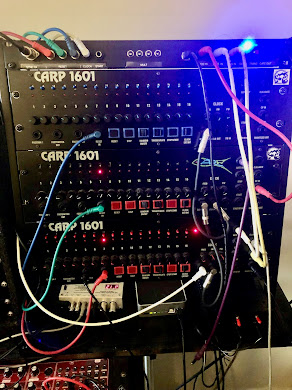CV to MIDI Interface for Analogue Sequencer
This is another project based on Arduino and the Pro Micro. Many years ago with the help of friend and fellow musician/programmer, Linden Owen, we produced the CARP1601. This was very loosely based on the ARP1601 analogue sequencer. It was never commercially viable due to the high component count and the cost of those components. 19 pots, 19 knobs, 17 LEDs, 24 switches, 15 jack sockets and then add on PCB, components case and PSU. Anyway, it was a fun project!
Note this project will work with any analogue sequencer that has Gate and CV outputs. Voltages may need to be scaled in the sketch using the map function.
 |
| 3 CARP 1601s with the SYNC24 and MIDI Interface |
We built about 6 in the end, sold a couple and I was left with 3 units that I have used constantly for more than 20 years. In 2022 I decided to make some improvements mainly to the gate switches. But towards the end of the 2022 I realised it would be relatively easy to add a board to the CARP rack that could provide MIDI Out and provide additional functions over MIDI that were never available on the original CARP.
 |
| MIDI Interface Board using a Pro Micro |
The CARP1601 is a basic 16 step single channel analogue sequencer but does feature 2 CV outputs, quantised and unquantised. The quantised outputs 0-5V which gives a 5 Octave range and is much larger than the original 2 octave range on the ARP. Unquantised provides 10 volts and it is this output that is fed into the Pro Micro board. It's quite easy to scale this input and then convert to Note Ons when a gate signal is received. The current interface only supports MIDI over USB but it would be simple to add a standard MIDI interface on 5 pin DIN.
Once the CV and Gate signals are received by the Pro Micro you can manipulate those voltages in interesting ways:
- Scales
- Transpose
- Gate or Pulse Width - only works when receiving Clock from computer sequencer.
Scales is simply a matter of using an array that maps incoming voltages to MIDI note numbers. I use a pushbutton to cycle through them. At the moment I just have the default which is Chromatic, followed by Pentatonic, Major and Natural Minor.
Transpose, transposes the sequence in semitone steps up 5 semitones and down 5 semitones.
Pulse Width is a feature that wasn't properly implemented on the original CARP. PW is available but only on the Clock and Gate output and only manually adjustable with the PW control.
 |
| MIDI Interface inputs and controls |
The CARP MIDI Interface accepts a 0-10V MOD input which can be used for MIDI CCs or in this case to control the length of the Gate. This introduces articlulation and using a 2nd CARP you can individually control the note value for each step. So step 1 4 and 7 might be crotchets while the other steps could be shorter like semiquavers. This makes sequencers more rhythmically interesting. The MOD input could also be used for velocity as well so gate length and velocity could be combined.
More information about ordering and building here
May 2025
Major update with the following improvements:
- Scales can now be selected with a Scale pot
- Scales include 3 Arpeggio patterns
- 7 standard scales including Blues
- Seq Modes selected by rotary switch (PW, Velocity and Ratchet)
- MIDI 5pin DIN added for standalone mode (does not support Ratchet)
- Transpose now selected with 11 position potentiometer -5 thru 0 to +5
Here's an annotated photo:

Comments